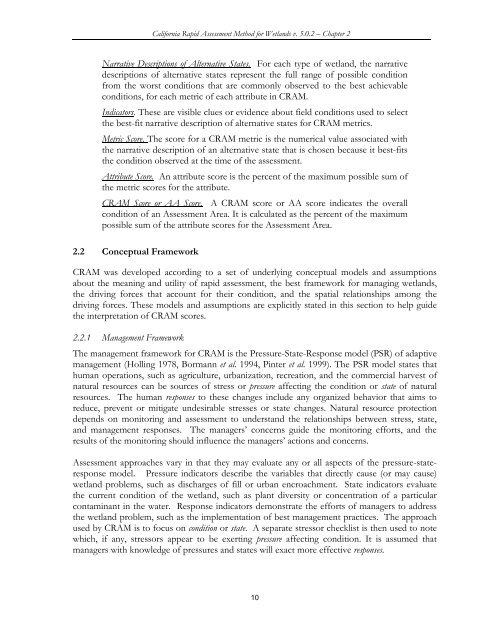(CRAM) For Wetlands User's Manual Version 5.0.2
(CRAM) For Wetlands User's Manual Version 5.0.2
(CRAM) For Wetlands User's Manual Version 5.0.2
You also want an ePaper? Increase the reach of your titles
YUMPU automatically turns print PDFs into web optimized ePapers that Google loves.
California Rapid Assessment Method for <strong>Wetlands</strong> v. <strong>5.0.2</strong> – Chapter 2<br />
Narrative Descriptions of Alternative States. <strong>For</strong> each type of wetland, the narrative<br />
descriptions of alternative states represent the full range of possible condition<br />
from the worst conditions that are commonly observed to the best achievable<br />
conditions, for each metric of each attribute in <strong>CRAM</strong>.<br />
Indicators. These are visible clues or evidence about field conditions used to select<br />
the best-fit narrative description of alternative states for <strong>CRAM</strong> metrics.<br />
Metric Score. The score for a <strong>CRAM</strong> metric is the numerical value associated with<br />
the narrative description of an alternative state that is chosen because it best-fits<br />
the condition observed at the time of the assessment.<br />
Attribute Score. An attribute score is the percent of the maximum possible sum of<br />
the metric scores for the attribute.<br />
<strong>CRAM</strong> Score or AA Score. A <strong>CRAM</strong> score or AA score indicates the overall<br />
condition of an Assessment Area. It is calculated as the percent of the maximum<br />
possible sum of the attribute scores for the Assessment Area.<br />
2.2 Conceptual Framework<br />
<strong>CRAM</strong> was developed according to a set of underlying conceptual models and assumptions<br />
about the meaning and utility of rapid assessment, the best framework for managing wetlands,<br />
the driving forces that account for their condition, and the spatial relationships among the<br />
driving forces. These models and assumptions are explicitly stated in this section to help guide<br />
the interpretation of <strong>CRAM</strong> scores.<br />
2.2.1 Management Framework<br />
The management framework for <strong>CRAM</strong> is the Pressure-State-Response model (PSR) of adaptive<br />
management (Holling 1978, Bormann et al. 1994, Pinter et al. 1999). The PSR model states that<br />
human operations, such as agriculture, urbanization, recreation, and the commercial harvest of<br />
natural resources can be sources of stress or pressure affecting the condition or state of natural<br />
resources. The human responses to these changes include any organized behavior that aims to<br />
reduce, prevent or mitigate undesirable stresses or state changes. Natural resource protection<br />
depends on monitoring and assessment to understand the relationships between stress, state,<br />
and management responses. The managers’ concerns guide the monitoring efforts, and the<br />
results of the monitoring should influence the managers’ actions and concerns.<br />
Assessment approaches vary in that they may evaluate any or all aspects of the pressure-stateresponse<br />
model. Pressure indicators describe the variables that directly cause (or may cause)<br />
wetland problems, such as discharges of fill or urban encroachment. State indicators evaluate<br />
the current condition of the wetland, such as plant diversity or concentration of a particular<br />
contaminant in the water. Response indicators demonstrate the efforts of managers to address<br />
the wetland problem, such as the implementation of best management practices. The approach<br />
used by <strong>CRAM</strong> is to focus on condition or state. A separate stressor checklist is then used to note<br />
which, if any, stressors appear to be exerting pressure affecting condition. It is assumed that<br />
managers with knowledge of pressures and states will exact more effective responses.<br />
10















